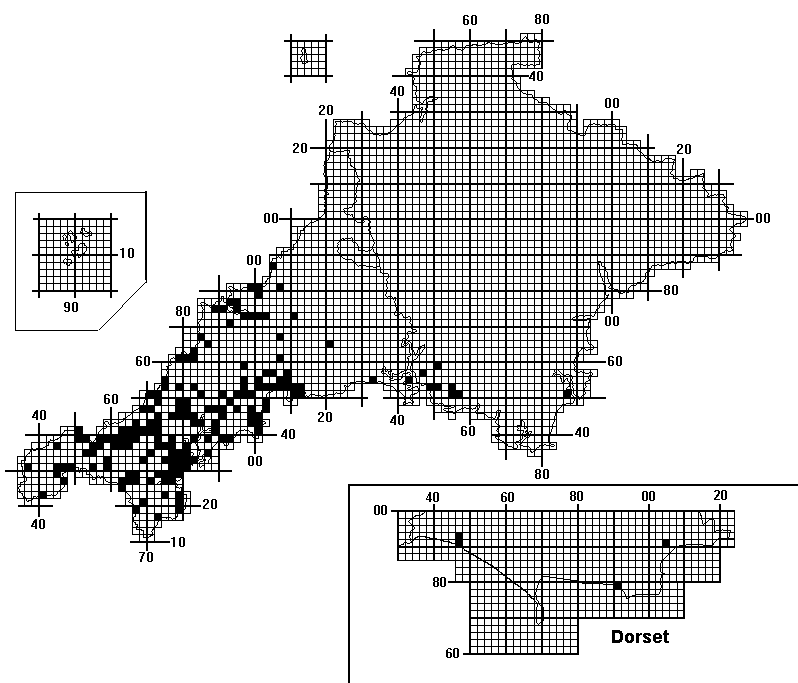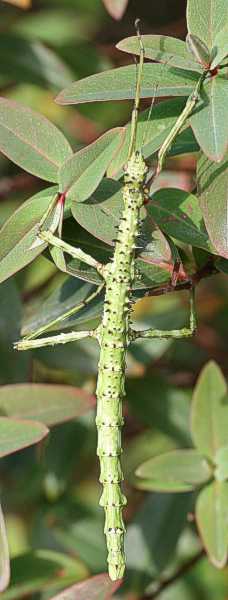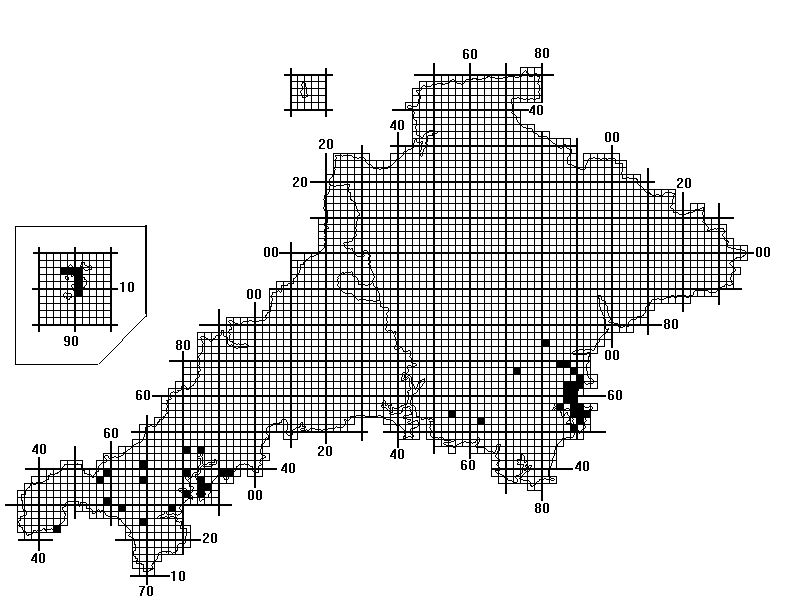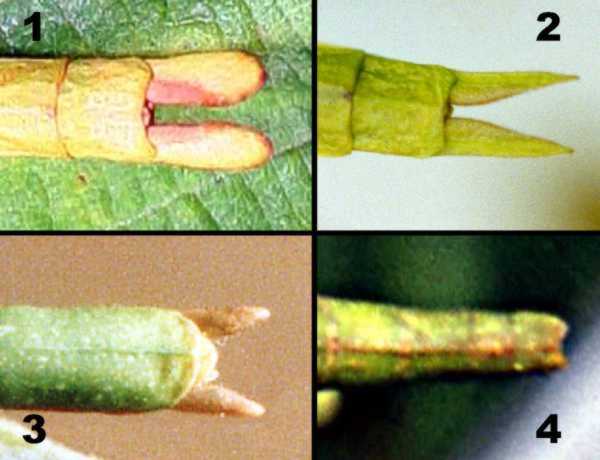The Naturalised British Stick Insects
By Malcolm Lee, November 2013
Have you seen stick insects in the UK?
Report your sighting! If you have been lucky enough to come across stick insects in the UK, please report your sighting here - we would be very grateful to hear from you. Your report will be sent to the collator of all records of the UK's naturalised stick insects, helping us to build an accurate picture of the distribution of these fantastic insects around the UK!
Introduction
For over 100 years stick insects have become naturalised in South West England and around the Bay of Kenmare in South West Ireland. There are three New Zealand species, two of which have become widely distributed, and one is found only on the Isles of Scilly. A Mediterranean species has also been found in the Isles of Scilly and on Hayling Island in the last few years.
Other species are kept as pets or for study, and discarded or escaped insects could turn up almost anywhere, although these cannot survive outdoors here.
Unarmed Stick Insect Acanthoxyla inermis


This is our most common species, accounting for 60% of all records. Most sites are in Cornwall but there are now quite a few records from Devon and further east in Dorset. The strongest colonies are found in the Truro, Falmouth, and St Austell areas in Cornwall, and the Plymstock area in Devon. This is also the species found in South West Ireland.
Since 2000, several garden centres in Cornwall and Devon have had this species within their grounds. This may well account for the significant expansion in range over the last decade, as we buy their plants for our gardens and the stick insects come too as eggs in the soil. As a tourist area, our visitors may well make such purchases for their gardens well outside the west country, so there is a possibility of the Unarmed Stick Insect turning up anywhere in the country.
This species has been here since the early part of the 20th century. It was certainly present at Treseder's Truro nursery in the 1920s, having arrived on plants brought over from New Zealand. Treseder's were the first to import Australasian plants commercially from late Victorian times. They also supplied the large gardens in South West Ireland, accounting for its occurrence there.
This is our longest UK insect with the adult body measuring up to 125mm, although about 100mm is more usual. It has a smooth body with just a few tiny bumps on it's back. Colour can be either green or brown, but green is more common. Green ones tend to be a uniform apple green and brown ones vary from a light straw colour through mahogany red to almost black.
Prickly Stick Insect Acanthoxyla geisovii


This species is found in two main areas: in Devon around Torbay, and in Cornwall around St Mawes. It is also widespread in the Isles of Scilly on Tresco, and more recently found on St Mary's and Bryher.
The earliest UK stick insect record was in 1909 from a garden in Paignton, Devon, which can be directly linked to a consignment of New Zealand plants imported there in 1903. On the Isles of Scilly it was first reported in 1943 from Tresco Abbey Gardens, although the colony must have arrived earlier as New Zealand plants had not been imported there since the war broke out in 1939. The recent colonies on the adjacent islands undoubtedly came about as a result of hitching a lift on plants swapped between gardens. Colonies on mainland Cornwall originated from the deliberate release of Tresco insects in a St Mawes garden c. 1959.
This species is readily identified as it has a body covered in small black spines. It is almost identical in size to the Unarmed Stick Insect and can similarly be green or brown in colour.
Smooth Stick Insect Clitarchus hookeri
This is the third New Zealand species. It is only found in the Isles of Scilly, where it was first reported from Tresco Abbey Gardens in 1949, probably arriving on plants imported around the same time as the Prickly Stick Insect. Like that species it has recently been found on the adjacent St Marys and Bryher, again as a result of movement of plant material. It is slightly smaller than the other New Zealand species, typically 90mm.
Mediterranean Stick Insect Bacillus rossius
A colony of this species was located on Tresco, Isles of Scilly in 2002 which still persists. Another colony has recently been found on Hayling Island, Hampshire, where it has been present since at least 2009. A colony of the closely related White’s Sicilian Stick Insect, Bacillus whitei, has survived in a handful of gardens in NW Slough since the early 1990s. This is not easily distinguishable from the Mediterranean Stick Insect. Both are natives of Southern Europe, the former being principally found near the Mediterranean coast, and the latter on Sicily. They are of a similar size to the Smooth Stick Insect.
Life Cycle: The naturalised stick insects seen in the UK are all female and reproduce by laying fertile eggs without the need for a male, a process known as parthenogenesis. Acanthoxyla males have never been found in New Zealand and probably do not exist. They all have a similar life cycle with eggs hatching out in Spring to form miniature adults about 12mm long. Development is rapid, as they are fully grown by mid-Summer. A few weeks later they start to lay eggs, typically 3 or 4 a day. These are simply dropped below the plant the adult is feeding on. Adults only live three or four months, with few surviving much into Winter. Overwintering of adults is not important for the survival of the colony, as it is the eggs that ensure the next generation. When these hatch the following Spring, the emerging nymphs climb the first stem they see, which is likely to be the plant the parent fed on the previous year. Bramble is always a favourite foodplant, although our stick insects will survive on many plant species, including evergreens like Leylandii hedging.
Non-naturalised species which may be seen outdoors
The most often non-naturalised species to be reported is the Indian or Laboratory Stick Insect, Carausius morosus. This is our most common stick insect in culture, often kept by children as it is readily available in pet shops. It is easy to keep but can be embarrassingly prolific. Each insect can lay up to a thousand eggs, many of which will hatch out in a matter of months. Whilst it cannot overwinter in our climate, it is occasionally found outdoors in Summer and Autumn as a result of the release of surplus insects. It is smaller than the other species, usually only 70mm.
There are many other exotic species kept in culture which occasionally escape but will not survive outdoors. A clear image may enable such stick insects to be identified.
Identification of Adult Phasmids
Phasmids are best identified as adults, when the key features are fully formed. The Prickly Stick Insect is identified from its black spines. The degree of spininess can be variable, and for those with few or small spines, they can sometimes be overlooked. If you have an image and can forward it with your report, this should enable your stick insect species to be confirmed.
Those without spines are all very similar but can be identified by comparing the end of the abdomen with these images.

Key:
1. Unarmed Stick Insect: rounded cerci. This is our most commonly reported stick insect.
2. Smooth Stick Insect: pointed cerci longer than last abdominal segment, with only a small gap separating them. This species is only found on the Isles of Scilly, but has often been confused with the Unarmed Stick Insect found on the mainland.
3. Mediterranean Stick Insect: pointed cerci half as long as last segment, widely separated (nb. small nymphs of the Unarmed Stick Insect may look similar). A further key indicator are the short antennae, only around a quarter the length of the front leg, whereas the antennae of the New Zealand species is about half the length of the front leg.
4. Laboratory Stick Insect: No visible cerci. Antennae almost as long as the front leg.
